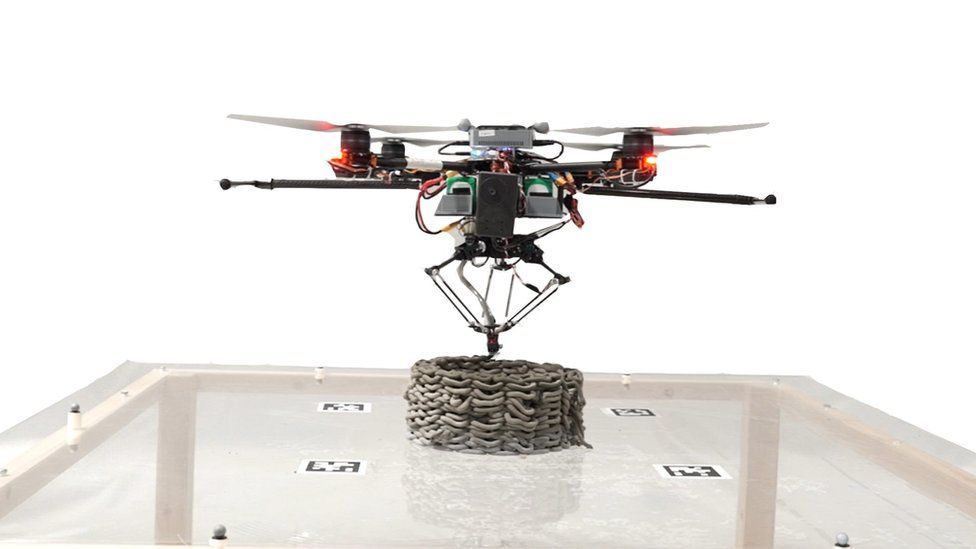

Flying 3D printer drones work like bees to fix buildings
source link: https://www.bbc.com/news/uk-england-bristol-62993125
Go to the source link to view the article. You can view the picture content, updated content and better typesetting reading experience. If the link is broken, please click the button below to view the snapshot at that time.

Flying 3D printer drones work like bees to fix buildings

A fleet of flying 3D printers has been designed to build and repair structures in-flight.
The drones use building methods similar to bees and wasps and were developed by a team at the University of Bath.
They could be used in manufacturing and construction in difficult-to-access places like on top of tall buildings, or dangerous locations to help with post-disaster relief construction.
The inventors say they could also cut costs and make construction safer.
3D printing has been gaining popularity in the construction industry and project investigator, Dr Richard Ball, said the new materials made use of unique properties needed for "aerial additive manufacturing".
These include being light-weight and quick-setting.
The drones in the fleet, known collectively as Aerial Additive Manufacturing (Aerial-AM), work jointly from a single blueprint, adapting their techniques as they go.
Although they are "fully autonomous" while flying, they are monitored by a person who checks their progress and can intervene if needed, to make decisions based on the information provided by the drones.
The work was published in science journal Nature.
Lead author Professor Mirko Kovac said his team had proven that drones can work independently and together to "construct and repair buildings, at least in the lab".
To prove the concept, researchers tested four cement-like mixtures for the drones to build with.
'Validate our solutions'
The drones assessed the printed geometry throughout the build in real-time and adapted their behaviour to meet the build specifications.
Researchers recorded the manufacturing accuracy as being to within "five millimetres".
They said the performance of the printed structure had to be accurately predicted to ensure "mechanical integrity through the printing process".
The proof-of-concept prints included a 2.05-metre (6.7ft) high cylinder (72 layers) with a polyurethane-based foam material, and an 18-centimetre (7ins) high cylinder (28 layers) with a custom designed structural cement-like material.
Dr Paul Shepherd, another project investigator, said the next step would be to work with construction companies to "validate our solutions and provide repair and construction capabilities".
Professor Kovac, director of the Aerial Robotics Laboratory at Imperial College London, who led the project, said they believed the fleet of drones could help reduce the cost and risk of construction in the future "compared to traditional manual methods".
Related Internet Links
</article
Recommend
-
 11
11
How bees and drones team up to find landminesBy Chris BaraniukTechnology of Business reporterPublished1 day agoimage copyrightBee4expimage captionBees can be trained to...
-
 8
8
August 24, 2021
-
 11
11
How remote flying of drones will transform the futureHow remote flying of drones will transform the futureAnyone piloting a drone usually needs to keep it in sight, but...
-
 12
12
Taser company nixes idea of using drones as flying stun guns to respond to mass shootings. Controversy caused some ethics-board members to quit.Áine CainTue, June 7, 2022...
-
 8
8
Please Delete Your Recordings: Inside a Police ConferencePolice, surveillance tech companies, and government contractors gathered to joke about law enforcement robots in locker rooms and talk about getting close to...
-
 13
13
5 Reasons Our Cities Are Not Full of Autonomously Flying Drones (Yet!)August 20th 2022 new story8
-
 8
8
The U.S. Military Wants To Power Bases With A Flying Chain Of Laser Drones ...
-
 5
5
December 2, 2022 ...
-
 8
8
On the fifth day of Christmas — Bees like to roll little wooden balls as a form of play, study finds It's “a strong indication that insect minds are far more sophisticated...
-
 9
9
Life and Living What if you did the exact opposite? (like the rogue...
About Joyk
Aggregate valuable and interesting links.
Joyk means Joy of geeK